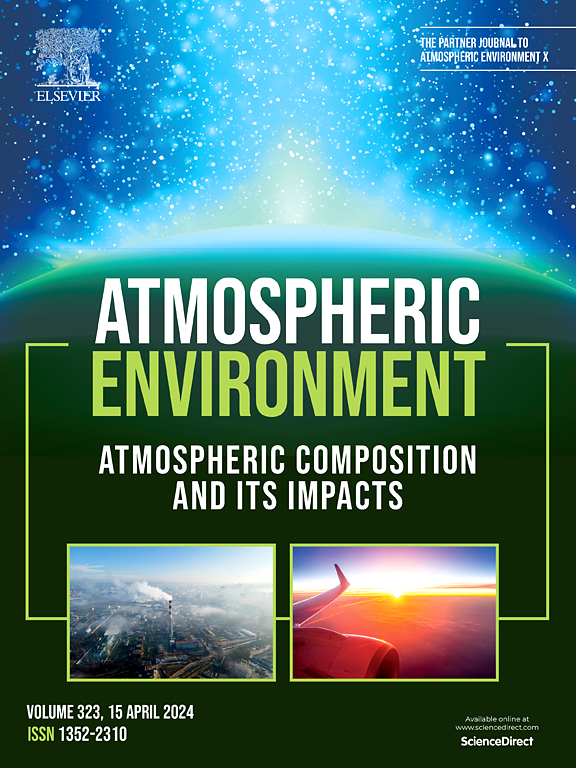地铁站中时间和尺寸分辨荧光生物气溶胶颗粒的分析
IF 4.2
2区 环境科学与生态学
Q2 ENVIRONMENTAL SCIENCES
引用次数: 0
摘要
地铁站是动态的地下环境,空气质量变化迅速,主要是由于乘客的占用模式和火车的频繁到达和离开。然而,传统的微生物监测方法受到时间分辨率的限制。为了解决这一问题,我们采用基于实时光致荧光的生物气溶胶监测仪器来检测颗粒物(PM)的动态,并根据生物气溶胶的固有荧光特性将其分为荧光生物气溶胶颗粒(FBAPs)和非FBAPs。我们在中国天津的一个典型地铁站的站台、车站大厅和室外部署了这个传感器,为期18天。结果表明,站台内FBAP和非FBAP浓度分别约为站厅的2倍和3倍,约为室外的3倍和4倍。值得注意的是,在大多数时间里,平台上的类细菌颗粒水平是室外值的20倍。以非fbap为主的PM浓度在早高峰时段在站台和车站大厅达到峰值,而细菌样颗粒在早上达到最低水平,可能是由于火车开始运行时金属颗粒水平升高,抑制了细菌的存活。列车运行强烈影响站台上的非fbap浓度,与列车时刻表相对应的粒子自相关的7分钟周期证明了这一点。相比之下,车站大厅的粒子水平在自相关中不表现出与列车相关的模式,但与环境参数表现出更强的相关性。揭示了地铁站非生物和生物空气悬浮粒子的动态模式,为未来减少颗粒物暴露提供了见解。本文章由计算机程序翻译,如有差异,请以英文原文为准。
Analysis of time- and size-resolved fluorescent biological aerosol particles in a subway station
Subway stations are dynamic underground environments where air quality changes rapidly, primarily due to passenger occupancy patterns and the frequent arrival and departure of trains. However, traditional microbial monitoring methods are constrained by their temporal resolutions. To address this, we employed a real-time light-induced fluorescence-based bioaerosol monitoring instrument to detect the dynamics of particulate matters (PM) and classify them into fluorescent biological aerosol particles (FBAPs) or non-FBAPs based on the intrinsic fluorescent feature of bioaerosols. We deployed this sensor on the platform, in the station hall, and outdoors at a typical subway station for 18 days in Tianjin, China. The results showed that FBAP and non-FBAP concentrations on the platform were roughly 2 and 3 times higher, respectively, than those in the station hall, and approximately 3 and 4 times higher than outdoor levels. Notably, the bacteria-like particle levels on the platform were 20 times higher than those outdoor values during most periods. The concentrations of PM, dominated by non-FBAP, peaked during the morning rush hours both on the platform and in the station hall, while the bacteria-like particles reached their lowest levels in the morning, presumably caused by the elevated metal particle levels when trains started operating that inhibit bacterial survival. Train operations strongly influenced non-FBAP concentrations on the platform, as evidenced by the 7-min periodic cycle in the particle autocorrelations corresponding to train schedules. By contrast, the particle levels in the station hall did not show train-related patterns in autocorrelations but showed stronger correlations with the environmental parameters. The revealed dynamic patterns of non-biological and biological airborne particles in the subway station provide insights for mitigating particle exposure in the future.
求助全文
通过发布文献求助,成功后即可免费获取论文全文。
去求助
来源期刊

Atmospheric Environment
环境科学-环境科学
CiteScore
9.40
自引率
8.00%
发文量
458
审稿时长
53 days
期刊介绍:
Atmospheric Environment has an open access mirror journal Atmospheric Environment: X, sharing the same aims and scope, editorial team, submission system and rigorous peer review.
Atmospheric Environment is the international journal for scientists in different disciplines related to atmospheric composition and its impacts. The journal publishes scientific articles with atmospheric relevance of emissions and depositions of gaseous and particulate compounds, chemical processes and physical effects in the atmosphere, as well as impacts of the changing atmospheric composition on human health, air quality, climate change, and ecosystems.
 求助内容:
求助内容: 应助结果提醒方式:
应助结果提醒方式:


